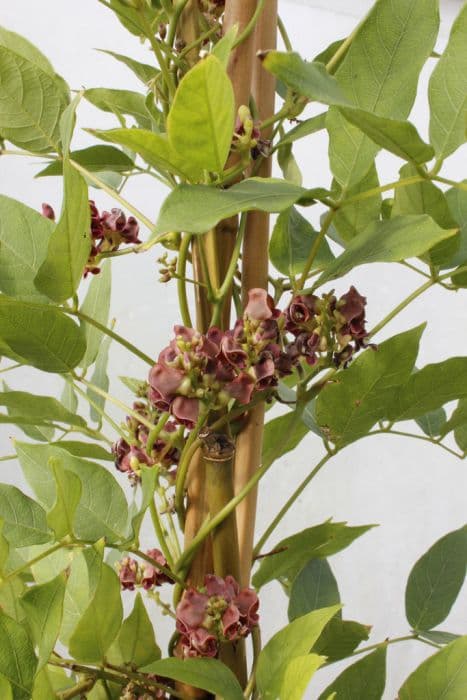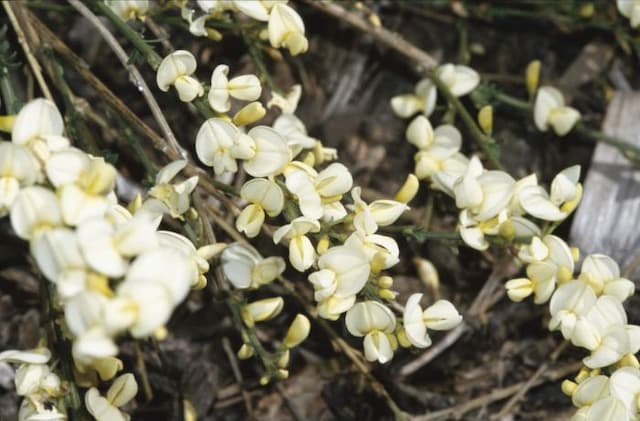Chinese redbud Cercis chinensis 'Don Egolf'

ABOUT
The 'Don Egolf' variety of the Chinese redbud is recognized for its exceptional ornamental qualities. In spring, this deciduous shrub becomes a focal point in the garden, awash with vibrant, deep-pink flowers that densely cover its gracefully arching branches. These blooms are not only eye-catching but small and sweetly shaped, adorning the plant long before the foliage emerges, enveloping it in a striking floral display. As the seasons change, the Chinese redbud's leaves unfurl to reveal a rich, heart-shaped foliage with a glossy, green surface. The leaves form a dense, multi-stemmed and bushy appearance, creating a full and lush profile that persists throughout the growing season. In the fall, the foliage may turn to attractive shades of yellow, adding a warm touch to the otherwise cooling landscape. The overall impression this plant imparts is one of robust vitality, showy flowers, and enduring charm, making it a cherished plant for gardeners seeking to enliven their outdoor spaces.
About this plant
 Names
NamesFamily
Fabaceae
Synonyms
Chinese Redbud, Don Egolf Chinese Redbud
Common names
Cercis chinensis 'Don Egolf'
 Toxicity
ToxicityTo humans
The Chinese redbud, including the 'Don Egolf' variety, is not commonly known to be toxic to humans. However, as with many plants, it is always advisable to exercise caution and keep plant parts away from children and pets who may incidentally ingest them, as individual sensitivity can vary and the possibility of allergic reactions or gastrointestinal upset cannot be entirely dismissed.
To pets
The Chinese redbud, which encompasses the 'Don Egolf' cultivar, is not widely recognized as being toxic to pets such as dogs and cats. Nonetheless, it's generally prudent to prevent pets from eating plants, as individual animals may have varying sensitivities, and ingestion of non-food items can lead to gastrointestinal discomfort or an obstruction. If you suspect your pet has ingested a large amount of plant material and is showing symptoms of distress, it is recommended to consult a veterinarian.
 Characteristics
CharacteristicsLife cycle
Perennials
Foliage type
Deciduous
Color of leaves
Green
Flower color
Pink
Height
8-10 feet (2.4-3 meters)
Spread
8-10 feet (2.4-3 meters)
Plant type
Tree
Hardiness zones
6-9
Native area
China
Benefits
 General Benefits
General Benefits- Ornamental Appeal: Cercis chinensis 'Don Egolf' is known for its beautiful profusion of pink to purple flowers that bloom in spring before the foliage emerges, providing a stunning ornamental display.
- Compact Size: This cultivar has a compact, dense growth habit, making it an ideal choice for smaller gardens or limited spaces.
- Low Maintenance: It is considered a low-maintenance plant, requiring minimal pruning and care once established.
- Drought Tolerance: Once established, it has good drought tolerance, making it suitable for xeriscaping or gardens in drier climates.
- Attracts Wildlife: The flowers of the 'Don Egolf' Chinese redbud attract pollinators such as bees, which are beneficial for garden biodiversity.
- No Seed Pods: Unlike the common redbud species, 'Don Egolf' does not produce seed pods, which can be considered a maintenance benefit in the landscape.
- Deciduous Foliage: The heart-shaped leaves provide autumn interest with their yellow fall color, adding seasonal appeal to the landscape.
 Medical Properties
Medical PropertiesThis plant is not used for medical purposes.
 Air-purifying Qualities
Air-purifying QualitiesThis plant is not specifically known for air purifying qualities.
 Other Uses
Other Uses- Art and Craft Material: The branches and seed pods of Chinese redbud 'Don Egolf' can be used in floral arrangements or as natural materials in art projects for texture and interest.
- Bonsai Specimen: Due to its attractive foliage and flowering habit, the Chinese redbud 'Don Egolf' can be trained as a bonsai for ornamental purposes.
- Photography Subject: With its stunning spring blooms, the Chinese redbud 'Don Egolf' makes a beautiful subject for photographers, particularly those interested in botanical and nature photography.
- Educational Tool: Botany and horticulture educators can use the Chinese redbud 'Don Egolf' to teach grafting techniques or the science of blooming in plant life cycles.
- Habitat Enrichment: The Chinese redbud 'Don Egolf' can be used in animal enclosures, such as aviaries, to provide perching options and enrich the living environment for birds.
- Nature-Inspired Design: The tree's unique shape and form can inspire architectural and interior designs, integrating shapes and patterns found in nature into human-made structures.
- Culinary Inspiration: While not directly edible, the flowers and form of the Chinese redbud 'Don Egolf' can inspire pastry chefs and bakers in creating decorative desserts that mimic its appearance.
- Gift Plant: Due to its compact size and ornamental value, the Chinese redbud 'Don Egolf' is suitable for gifting as a potted plant for special occasions like housewarmings or as living memorials.
- Film and Theatre Sets: Its eye-catching springtime appearance can be utilized as a backdrop in films or theatre productions to convey the essence of spring or to add visual interest to a scene.
- Seasonal Festivities: Can be integrated into event decor, especially during spring celebrations and festivities where its bloom coincides with the event's theme or timing.
Interesting Facts
 Feng Shui
Feng ShuiThe Chinese redbud is not used in Feng Shui practice.
 Zodiac Sign Compitability
Zodiac Sign CompitabilityThe Chinese redbud is not used in astrology practice.
 Plant Symbolism
Plant Symbolism- Love and Affection: The common name of Cercis chinensis 'Don Egolf' is Chinese redbud, and redbud trees are often associated with love and affection due to their heart-shaped leaves and the welcoming display of early spring flowers.
- Renewal and Hope: Chinese redbuds flower in early spring, symbolizing renewal and the hope that comes with the onset of a new season.
- Beauty and Grace: The stunning pink to purple blossoms of the Chinese redbud represent beauty and grace, highlighting the tree's ornamental value in gardens and landscapes.
- Judgment: In Christian symbolism, the redbud is thought to be the tree that Judas hanged himself from, thus also representing judgment or betrayal; however, this connection may be lesser known or not commonly applied to the cultural symbolism of the plant.
 Water
WaterThe Chinese redbud 'Don Egolf' should be watered deeply and thoroughly to encourage a strong, deep root system. Under normal conditions, watering once a week with about 1-2 gallons of water should be sufficient. During the first growing season, it's crucial to maintain a consistent watering schedule to establish the plant. In times of extreme heat or drought, increase the frequency to twice a week. Always check the soil moisture level before watering; it should be moist but not waterlogged.
 Light
LightThe Chinese redbud 'Don Egolf' thrives in full sun to partial shade. It is optimal to plant it in a spot where it receives at least six hours of direct sunlight per day, although it can tolerate some light shade. Avoid deep shade locations as this will reduce the abundance of the plant's flowering.
 Temperature
TemperatureThe Chinese redbud 'Don Egolf' is hardy and can tolerate a wide range of temperatures, typically from 10°F to 100°F. The ideal temperature for promoting growth and flowering lies between 60°F and 80°F. It is important to protect the tree from extreme cold and frost, especially when newly planted.
 Pruning
PruningPruning the Chinese redbud 'Don Egolf' is essential to maintain its shape and remove any dead or damaged branches. Prune after flowering to avoid cutting off any of next season's blooms, typically in late spring or early summer. It does not require rigorous pruning, so only thin as needed to enhance the tree's natural form.
 Cleaning
CleaningAs needed
 Soil
SoilChinese Redbud 'Don Egolf' thrives in well-draining soil rich in organic matter with a pH between 6.0 and 7.5. A mix of garden soil, compost, and some sand or perlite is suitable for good root growth.
 Repotting
RepottingChinese Redbud 'Don Egolf' does not require frequent repotting as it is a slow grower; repot every 3-5 years, or when the root system outgrows the pot.
 Humidity & Misting
Humidity & MistingChinese Redbud 'Don Egolf' is tolerant of a wide range of humidity levels but prefers moderate humidity; excessive dryness or moisture in the air should be avoided.
 Suitable locations
Suitable locationsIndoor
Ensure bright indirect light and room to grow.
Outdoor
Plant in well-draining soil, full sun to partial shade.
Hardiness zone
6-9 USDA
 Life cycle
Life cycleThe Chinese redbud 'Don Egolf' begins its life as a seed, which, under optimal conditions, will germinate and sprout into a seedling. The young plant will then grow into a juvenile tree, characterized by rapid growth and the development of a root system and foliage. As it matures into an adult tree, the Chinese redbud 'Don Egolf' experiences a period of vegetative stability where it will grow flowers and seeds each spring, following a period of dormancy in the winter. During its flowering stage, usually in early spring before the leaves unfurl, this redbud is covered in vibrant, magenta-colored flowers that attract pollinators. As it reaches reproductive maturity, it produces seed pods which eventually dry and release seeds to propagate the next generation. The tree will continue this cycle, potentially for several decades, until it reaches the end of its lifespan and dies, often giving way to new plants that continue the species' biological legacy.
 Propogation
PropogationPropogation time
Spring-Early Summer
The Chinese redbud 'Don Egolf' is commonly propagated by softwood cuttings, a process that can be done during the late spring to early summer when the plant’s new growth is still flexible but mature enough to take root. To propagate by cuttings, a gardener should snip a healthy stem of about 4 to 6 inches (approximately 10 to 15 cm) in length, making sure it contains at least a couple of leaf nodes. The lower leaves are removed, and the cut end dipped into a rooting hormone to promote root development. The cutting is then placed in a well-draining soil mix or a rooting medium, such as perlite or sand, and the environment should be kept humid by covering the cutting with a plastic bag or placing it in a propagator. Indirect light is best to prevent the cutting from drying out while the new roots are developing. Regularly misting and checking for root growth over several weeks will help ensure successful propagation.









